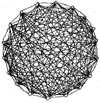 Call me a geek, but if this isn’t the sexiest paper ever written, I don’t know what is. Dr. Salingaros, where have you been all my life? If you know me, it shouldn’t surprise you that the mere mention of fractal geometry having anything to do with ecologically sound urban environments gets my blood circulating. In fact, the human circulation system, or more specifically the concept of capillarity, is one of the geometric models described in Salingaros’ “Connecting the Fractal City” (hereafter referred to as “The Sexypaper”).
Call me a geek, but if this isn’t the sexiest paper ever written, I don’t know what is. Dr. Salingaros, where have you been all my life? If you know me, it shouldn’t surprise you that the mere mention of fractal geometry having anything to do with ecologically sound urban environments gets my blood circulating. In fact, the human circulation system, or more specifically the concept of capillarity, is one of the geometric models described in Salingaros’ “Connecting the Fractal City” (hereafter referred to as “The Sexypaper”).
Stepping back a bit – a fractal is a geometric structure in which the same shape is repeated on all different scales (see visual examples). I stumbled across the phrase “urban fractals” quite by accident yesterday, and the mere phrase conjured up images of the most superbly ecological and efficient cities – where within the whole city there are near-self-sufficient neighborhoods, each containing a microcosm of the whole with all of its parts (residential, commercial, governmental, parks, etc). And within each neighborhood, smaller details within that – homes which produce their own energy, food, and services, and so on.
So where does The Sexypaper come in? The Sexypaper takes this concept of the urban fractal, describes it in all of its mathematical, ecological, cultural, historical, and architectural beauty, and lays out a (rather convincing) argument that fractal properties are not only natural but necessary to the living city, that the extreme densities of contemporary cities (with skyscraper-filled centers and suburban sprawl) are “pathological.” Plus it then goes on to offer that it is indeed possible to integrate the pedestrian network with the car city, that the electronic city should serve as a model for the ideal structure of the physical city (seems intuitive enough – take the efficiency of traffic on Wikipedia for example), and it offers the beginnings of a pattern language to aid in this challenge.
And it has pretty pictures.
April 5, 2007 at 1:49 pm |
Yeah, you’re a geek. A good geek.
November 2, 2009 at 12:10 pm |
Great Post
thank you